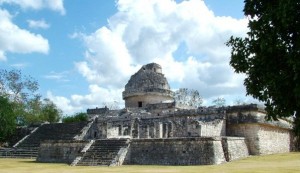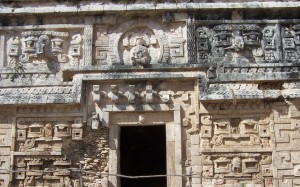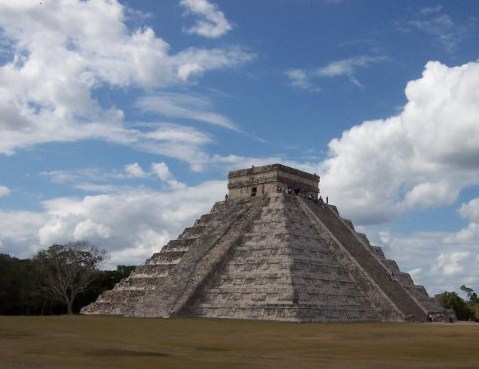Volviendo a Chichén Itzá: sus edificios. Posted by Magda on Jun 21, 2011 in Spanish Culture
Se acerca el solsticio de verano, y me preguntaba como sería pasarlo en un lugar especial, mágico. ¿Se os ocurre alguno? Dejadme que os hable de uno de ellos…
En la península del Yucatán, en México, quedan las reliquias de una de las ciudades mayas más poderosas: Chichén Itzá. Los mayas, una civilización que apareció hace más de 3.000 años en lo que hoy es Honduras, México, Guatemala, y Belice, y que alrededor del año 900 D.C. desapareció de forma repentina. Tan solo permanecieron en México hasta la conquista española en el siglo XVI.
Los mayas crearon un lenguaje escrito muy sofisticado, tenían un sistema de clases sociales, eran expertos matemáticos y astrónomos. Incluso los edificios de esta ciudad ceremonial fueron construidos alineados con eventos astronómicos: cada equinocci o la gente se congrega cerca de “El Castillo” o “Pirámide de Kukulkan”, la conocida pirámide en el centro de Chichén Itzá, para ver a la serpiente, una aparición creada por sombras que desciende por las escaleras. Se pensaba que era una manifestación de su dios Kukulkan (literalmente “serpiente emplumada”). Las combinaciones de luces y sombras reflejadas en la pirámide eran incluso usadas como un inmenso calendario para la siembra, la cosecha y las celebraciones.
o la gente se congrega cerca de “El Castillo” o “Pirámide de Kukulkan”, la conocida pirámide en el centro de Chichén Itzá, para ver a la serpiente, una aparición creada por sombras que desciende por las escaleras. Se pensaba que era una manifestación de su dios Kukulkan (literalmente “serpiente emplumada”). Las combinaciones de luces y sombras reflejadas en la pirámide eran incluso usadas como un inmenso calendario para la siembra, la cosecha y las celebraciones.
“El caracol”, el edificio con la parte alta redondeada que vemos en la imagen, es una de las construcciones mejor preservadas: era el lugar donde, bajo los efectos de algunas sustancias, los astrónomos pasaban días y noches observando los cielos. También llamado “El observatorio”, estaba alineado con las posiciones de Venus, uno de los planetas más importantes para la cultura maya, así como con el amanecer del solsticio de verano y la puesta de sol del solsticio de invierno. Venus era considerado el planeta gemelo del sol, y un dios de la guerra, así que era el lugar perfecto al que mirar cuando planeaban una batalla. ¡Fueron grandes guerreros!
Llegó el momento de hacer una pausa, pero si no os importa, volveré a este tema en algún otro post. ¡Me fascina el mundo maya!
We are very close to the summer solstice, and I was just wondering what it would be like to live in a special, magical place. Can you think of any? Let me talk about one of them…
In the region of Yucatan, in Mexico, there lie the relics of one of the most powerful Mayan cities: Chichen Itzá. Mayans, a civilization which appeared over 3000 years ago in what today is Honduras, Mexico, Guatemala, and Belize, and suddenly disappeared around AD 900. They only remained in Mexico until the Spanish conquest in the 16th century.
The Mayans created a very sophisticated written language, they had a social class system, were expert mathematicians and astronomiers. Even the buildings in this ceremonial center were built to align with astronomical events: every equinox people gathered next to “El Castillo” (the castle) or “The piramid of Kukulkan”, the well-known piramid at the center of Chichen Itzá, to see “the snake”, an apparition made of shadows which descends down the stairs. It was thought to be a manifestation of their god Kukulkan (literally “the feathered serpent”). The patterns of light and shadow reflected in the piramid where even used by Mayans as a big calendar to sow, harvest, and hold ceremonies.
“El caracol” (the snail), the ruined rounded-top building we can see in the image, is one of th e best preserved buildings: there, under the effects of some substances, astronomers spent days and nights looking at the sky. Also known as “The Observatory”, it was aligned with the motions of Venus, one of the most important planets for Mayan culture, as well as with both the summer solstice sunrise and the winter solstice sunset. Venus was considered the sun’s twin, and a war god, so it was the perfect place to look at when planning a battle. They were great warriors!
e best preserved buildings: there, under the effects of some substances, astronomers spent days and nights looking at the sky. Also known as “The Observatory”, it was aligned with the motions of Venus, one of the most important planets for Mayan culture, as well as with both the summer solstice sunrise and the winter solstice sunset. Venus was considered the sun’s twin, and a war god, so it was the perfect place to look at when planning a battle. They were great warriors!
Now it’s time to take a break, but if you don’t mind, I’ll return to this topic in some other post. I’m fascinated by the Mayan world!

Build vocabulary, practice pronunciation, and more with Transparent Language Online. Available anytime, anywhere, on any device.





Comments:
Andreas:
¡Hola Magda!
Esperaré con impaciencia tu otro blog sobre los mayas. Una de las razones por las cuales estudio el español (aparte del motivo de que el mundo hispanoblante propio me gusta tanto )es que me incantan las civilizaciones precolombianas.
Andreas
Magda:
¡Estupendo Andreas!
A mi también me encantan, crecí leyendo sobre incas y mayas, y poder visitar algunos de esos lugares fue una experiencia maravillosa. En ese caso, espero que el siguiente post también te guste. Un saludo.